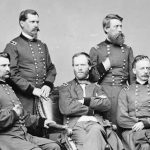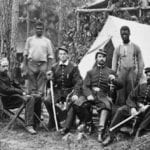 Weird Stuff
Weird Stuff  Weird Stuff
Weird Stuff  Mysteries
Mysteries 10 Tragic Disappearances and Deaths in Joshua Tree National Park
 History
History 10 Ways Childhood Really Sucked in the Old West
 Music
Music 10 Name Origins of Famous Bands from the 1990s
 Religion
Religion 10 Biggest Turnarounds by the Catholic Church
 Weird Stuff
Weird Stuff 10 Unbelievable Times Laws Had Unintended Consequences
 Humans
Humans Ten Historic Women Who Deserve Way More Credit Than They Got
 Movies and TV
Movies and TV 10 Films That Spawned Major Lawsuits
 History
History Ten Times Towns Were Wiped Off the Face of the Earth
 Creepy
Creepy 10 of the Most Disturbingly Haunted Public Houses in the UK
 Weird Stuff
Weird Stuff 10 Niche Subcultures That Are More Popular Than You Might Think
 Mysteries
Mysteries 10 Tragic Disappearances and Deaths in Joshua Tree National Park
 History
History 10 Ways Childhood Really Sucked in the Old West
Who's Behind Listverse?

Jamie Frater
Head Editor
Jamie founded Listverse due to an insatiable desire to share fascinating, obscure, and bizarre facts. He has been a guest speaker on numerous national radio and television stations and is a five time published author.
More About Us Music
Music 10 Name Origins of Famous Bands from the 1990s
 Religion
Religion 10 Biggest Turnarounds by the Catholic Church
 Weird Stuff
Weird Stuff 10 Unbelievable Times Laws Had Unintended Consequences
 Humans
Humans Ten Historic Women Who Deserve Way More Credit Than They Got
 Movies and TV
Movies and TV 10 Films That Spawned Major Lawsuits
 History
History Ten Times Towns Were Wiped Off the Face of the Earth
 Creepy
Creepy 10 of the Most Disturbingly Haunted Public Houses in the UK
Ten Things You Were Never Taught About the Civil War
The American Civil War is a defining moment in history. But beyond its well-known narratives lie intriguing lesser-known facts. While it is commonly studied by high school and college students all across the country, not everything about it is common knowledge. So, today, let’s delve into the shadows of history and seek out some of the most overlooked things about the awful civil conflict.
The people who fought in the Civil War were unique and fascinating. Their motives were more complex than what first meets the eye—and their actions were more complicated than what the history books would sometimes have us know. In this list, we’ll take a look at ten lesser-known facts about the Civil War and its combatants. These facts aren’t often part of the general public knowledge about the war, but they were part of its reality all the same. This is what you never knew about the Civil War…
Related: 10 Little-Known Facts About The Second World War
10 Disease Took Most
The Civil War took more lives than any other American conflict. But it wasn’t the battlefield that claimed most men. In reality, disease was by far the leading cause of death. Over 600,000 men lost their lives in the four years of battle. That surpasses the combined casualties of World War I, World War II, the Korean War, and the Vietnam War. If the names of the Civil War dead were listed like on the Vietnam Memorial, it would stretch over ten times its length. The war claimed the lives of 2% of the population. That would be equivalent to more than six million men today. But the mortality causes weren’t what you think.
While rifles were the deadliest weapons in the war, disease proved far worse. Surprisingly, it was not the direct fighting that claimed the majority of lives but rather the spread of sickness. In 1861, as armies gathered, soldiers abandoned the protection of relatively isolated rural life. They marched together and then slept closely in poorly ventilated tents. This led to the rapid transmission of contagious illnesses. Mumps, chickenpox, and measles were common. Malaria alone affected one million Union soldiers. Epidemics were frequent occurrences in the camps—and extremely deadly every time.[1]
9 Tecumseh’s Terrible Tirades
William Tecumseh Sherman remains one of the most famous and vicious Union generals who led troops during the Civil War. But once upon a time, he faced demotion due to his perceived mental health issues. Back in October 1861, Sherman was leading Union forces in Kentucky. He requested 60,000 soldiers to defend his territory and a whopping 200,000 troops for an offensive.
U.S. Secretary of War Simon Cameron dismissed his plea as “crazy.” Then, he stripped Sherman of his command. A heartbroken Sherman confessed to his brother in a letter that he contemplated suicide over it. He chose not to go through with it, though, for the sake of his children. And yet he even doubted his ability to lead again.
However, in February 1862, Sherman found a new assignment in Paducah, Kentucky. That came under the leadership of Ulysses S. Grant. Unlike others, Grant recognized Sherman’s competence amid the anguish and disgrace. Grant backed Sherman’s belief in troop movements, and for them, well, the rest was soon history.
Later, as the war trudged on, Sherman once fiercely defended his friend when a civilian criticized Grant. “General Grant is a great general,” Sherman fumed. “He stood by me when I was crazy, and I stood by him when he was drunk; and now, sir, we stand by each other always.”[2]
8 General Gloom and Doom
During the Civil War, it was the generals, not the privates, who faced the highest risk of death. Unlike in modern wars, it was common for top officers like generals to personally lead their troops into battle. Obviously, just being there in the first place made things far more dangerous for these esteemed men. In fact, it made them 50% more likely to die in combat compared to privates throughout the war.
A prime example is Confederate General Robert E. Lee. In May 1864, he wanted to lead a counterattack during the Battle of the Wilderness. However, his troops held him back. They were worried that the raid was ill-advised and that he’d become a target to boost Union morale. If Lee held a lower rank, his men wouldn’t have found his impulse so alarming. And yet his hands-on approach was typical for many generals of the time. In later wars, though, generals backed off from fighting and counseled men on troop movements from afar.
The Battle of Antietam saw a particularly grim toll on both sides. Three generals were killed, and six more were seriously wounded there. Similarly, at the Battle of the Wilderness, Confederate General James Longstreet was shot accidentally by one of his own men in the shoulder and throat. Fortunately, he survived and continued to command. He even ended up outliving many generals and privates, passing away four decades after the war’s end. Still, life was hard on the men tasked with leading armies during the Civil War—far harder than you might expect.[3]
7 Abe’s Almost-Assassination
Abraham Lincoln narrowly escaped death several years before his infamous assassination. Surprisingly, this incident remained shrouded in secrecy, unknown to many around the president. And that was exactly what Lincoln himself desired. In the summer of 1864, after a grueling day at the White House, Lincoln took a solitary journey to the Soldiers’ Home. It was his family’s seasonal retreat, and he intended to go there to unwind and rest.
As he approached the entrance, a single gunshot shattered the calm night air. Within moments, his horse stormed into the compound. Lincoln was clutching onto its back, hatless. Recounting the harrowing encounter later, Lincoln revealed the shot had been fired near the hill. It caused the horse to bolt and dislodge his hat.
Amazingly, when attendants found his hat later, they determined it bore a visible bullet hole. Sensing the gravity of the situation, Lincoln requested the guards to conceal the incident. He wanted to shield his beloved wife, Mary, from any more unnecessary distress. Of course, it’s chilling to think what might have been if that bullet had been aimed just a few inches lower.[4]
6 Lee’s Esteemed Estate
During the Civil War, Robert E. Lee’s Virginia estate, called Arlington, was taken by the Union. Lee and his wife Mary had left their 1,100-acre estate as war approached. Arlington overlooked Washington, D.C., which was prime ground for the Union. So, in 1863, the U.S. government officially seized the property. They cited Lee’s unpaid taxes amounting to $92.07 and took control. Then, the North summarily transformed it into a cemetery.
President Lincoln approved the establishment of a cemetery on the site, wanting a place to honor the Union dead. A burial vault was constructed on the estate’s former rose garden. The intention was for Lee to confront the consequences of his actions in the war. Lincoln wanted him to witness the graves and the devastation caused by the awful battles. After the war, the Lee family considered reclaiming Arlington for a time. However, they ultimately chose to abandon it altogether.
In 1877, their eldest son, George Washington Custis Lee, sued the federal government. He asserted that Arlington had been unlawfully confiscated. The Supreme Court ruled in his favor and quickly returned the property to him. However, with an estate filled with the remains of fallen soldiers, the Lee family faced a dilemma. George Lee ultimately sold Arlington back to the government—this time for $150,000. Over time, the site evolved into what is now known as Arlington National Cemetery. Today, it serves as the resting place for approximately 250,000 soldiers.[5]
5 Tubman’s Raid
Harriet Tubman infamously escaped slavery and then led others to freedom on the Underground Railroad. But during the Civil War, she embarked on another significant mission. Arriving at the Union camp in Port Royal, South Carolina, in 1862, Tubman dedicated herself to supporting the Northern cause. Initially, she taught freed women valuable skills for employment with the Union Army. Then, she quickly transitioned into gathering vital information from freed Blacks. She even started conducting reconnaissance trips along the river. But that was nothing compared to the war she directly waged on the South.
On June 1, 1863, Tubman joined forces with Union Colonel James Montgomery. Together, they led 300 Black Union soldiers deep into enemy territory at Combahee Ferry. As Union gunboats blared their whistles, the troops marched through nearby plantations. They set homes and barns ablaze and freed slaves.
Years later, Tubman recalled how the sight of men, women, and children escaping their enslavement reminded her of the biblical story of the Israelites fleeing Egypt. Astonishingly, over 720 slaves were liberated during this mission. It was a remarkable accomplishment—especially considering how brazen the raid turned out to be.
Harriet Tubman’s raid during the Civil War marked an extraordinary milestone, too: It was the first instance of a woman leading such a military operation. That it was such a success only added to Tubman’s incredible legacy. And it made her an even more feared insurgent as far as the Confederates were concerned.[6]
4 Lincoln’s Plans for Freed Slaves
Both before and during the Civil War, Abraham Lincoln advocated for sending freed Black people out of the country. This policy was known at the time as “colonization.” And it even had the backing of influential figures like Thomas Jefferson, James Madison, Andrew Jackson, Henry Clay, and Harriet Beecher Stowe. In fact, the characters in Stowe’s book Uncle Tom’s Cabin eventually relocated from the United States to Africa. As it turns out, that was a common idea during much of the 19th century.
In August 1862, Lincoln invited five Black ministers and anti-slavery speakers to the White House. During the meeting, he expressed his belief that slavery and the war had shown that it would be beneficial for both sides to separate. He proposed sending freed Blacks to Central America. He even suggested a constitutional amendment to authorize Congress to finance colonization.
However, prominent abolitionists like Frederick Douglass and William Lloyd Garrison strongly opposed this idea. Lincoln failed to gain sufficient support for the policy from other politicians in Washington, too. Then, once he signed the Emancipation Proclamation, he never publicly mentioned colonization again.[7]
3 No Pay, No Fight
During the Civil War, Black Union soldiers took a stand against unequal wages. While white soldiers earned at least $13 per month, Black soldiers were paid only $10. To make matters worse, Black soldiers were also charged a $3 monthly fee for clothing costs, thus reducing their pay to $7. This meant that the highest-paid Black soldier earned just half of what the lowest-paid white soldier received. Obviously, for men risking their lives for the Union cause, that didn’t sit well.
In response, Black regiments refused to accept these poor wages. They threatened to quit fighting altogether if they weren’t paid appropriately. Their bravery on the battlefield, combined with pressure from abolitionist congressmen, led Congress to address the issue.
In the fall of 1864, Black soldiers finally received pay commensurate with their white counterparts. They were also offered back pay retroactive to their enlistment period. This major change allowed many soldiers to send money back home to their families for the very first time. And most importantly for the Union cause, it kept much-needed men fighting on the front lines against the Confederate insurgents.[8]
2 Lee’s Brutal Ways
Everybody throughout history believes that General Ulysses S. Grant caused the most bloodshed of the Civil War. But that’s actually not the case. His Union men were undoubtedly brutal on foes. And the war was brutal on them, too, with Grant pushing hard and losing troops left and right even as he won battles.
Take, for example, the Overland Campaign in 1864. Grant’s troops suffered terrible losses during that run, with twice as many casualties as Robert E. Lee’s army. Mary Lincoln infamously referred to Grant as a “butcher” because of this. But the future president didn’t cause nearly as much bloodshed as Lee.
When looking at casualties in proportion to the size of the armies, Lee’s army endured far worse fates than the Union throughout the war. Lee had a fondness for launching vicious attacks at all times. That led to major southern victories like Chancellorsville and Fredericksburg. But it also resulted in major defeats and unfathomable troop losses. Lee was fighting aggressively for the Confederates throughout the war, but it came at the cost of thousands upon thousands of his men. Soon enough, his depleted armies felt the toll of constant death even more so than Grant’s faction.[9]
1 Soldiers from All Over
During the Civil War, the Union Army had a remarkably diverse makeup. Immigrants comprised about one-third of the soldiers. And freed slaves and other African Americans made up nearly one in ten. In sum, the Union Army effectively created an early multicultural—and even multinational—force.
Irish soldiers were the most well-known immigrant fighters, comprising nearly 8% of the army. But there were also significant numbers of Germans—nearly 10% of total fighters—who formed regiments like the Steuben Volunteers. Other immigrant soldiers came from France, Italy, Poland, England, Scotland, Wales, and many more.
The numbers backed it up, too. About 25% of the Union’s nationwide battalions were staffed by a majority of immigrant soldiers. Then, in 1863, Black men were finally allowed to enlist and join the fight for their freedom as well. Looking back on it now, some historians suggest their flood into participation may have had a decisive impact on the war’s outcome over its last two years.
Regardless, the Union Army’s composition reflected a diverse mix of immigrants and Black men. It’s easy to think about northern White soldiers fighting for emancipation, but the reality at the time was far more varied than that. Many of all backgrounds contributed to the cause![10]








